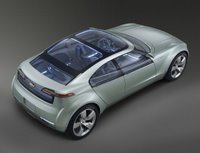Chevrolet Volt concept

General Motors was the first manufacturer to offer its EV1 electric vehicle for lease in the United States back in 1996. Poor range, costly battery packs and limited passenger space ultimately caused the vehicle to find a place in the automotive graveyard, but GM has continued to showcase concepts built around alternative propulsion systems.
The Volt concept is Chevrolet’s most recent take on the next generation of alternative-fuelled vehicles. It employs a system called “E-flex” which uses petrol, ethanol, bio-diesel
 or hydrogen to produce electricity. Under the sweeping four-door concept’s skin lies either a lithium-ion battery — with auxiliary petrol-powered 1-litre three-cylinder turbocharged engine — or a hydrogen-powered fuel cell with storage tanks at the rear.
or hydrogen to produce electricity. Under the sweeping four-door concept’s skin lies either a lithium-ion battery — with auxiliary petrol-powered 1-litre three-cylinder turbocharged engine — or a hydrogen-powered fuel cell with storage tanks at the rear.With the electrical hardware the Volt achieves 160hp and 236lb-ft of torque and is able to travel on electricity alone for up to 40 miles, completely negating the use of fuel. Recharging of the battery is accomplished either by the engine spinning at constant speed or by plugging the car into a 110-volt outlet for 6 hours. When running on E85, the Volt concept’s 150mpg fuel economy translates into more than 525 miles per petroleum gallon.
 GM’s new propulsion architecture allowed greater flexibility for the interior design team from England. Four individual bucket seats and a clean minimalist dashboard combine with a transparent upper roof section to provide an airy, spacious cabin with ample natural light, enhanced by thin pillars. Current or near-term technologies and materials join extensive use of indirect LED ambient lighting around the roof periphery and highlight the storage areas. The roof, side glass and beltline are constructed of a transparent, glazed polycarbonate material that delivers the scratch resistance and gloss surface appearance of glass, combined with the formability of a plastic composite and decreased weight.
GM’s new propulsion architecture allowed greater flexibility for the interior design team from England. Four individual bucket seats and a clean minimalist dashboard combine with a transparent upper roof section to provide an airy, spacious cabin with ample natural light, enhanced by thin pillars. Current or near-term technologies and materials join extensive use of indirect LED ambient lighting around the roof periphery and highlight the storage areas. The roof, side glass and beltline are constructed of a transparent, glazed polycarbonate material that delivers the scratch resistance and gloss surface appearance of glass, combined with the formability of a plastic composite and decreased weight.The Chevrolet Volt is certainly a glimpse into the future and GM expects upcoming concepts to incorporate diesel generators, bio-diesel and pure ethanol (E-100) as it strives to create alternatives to conventionally-fuelled vehicles.

0 Comments:
Post a Comment
<< Home